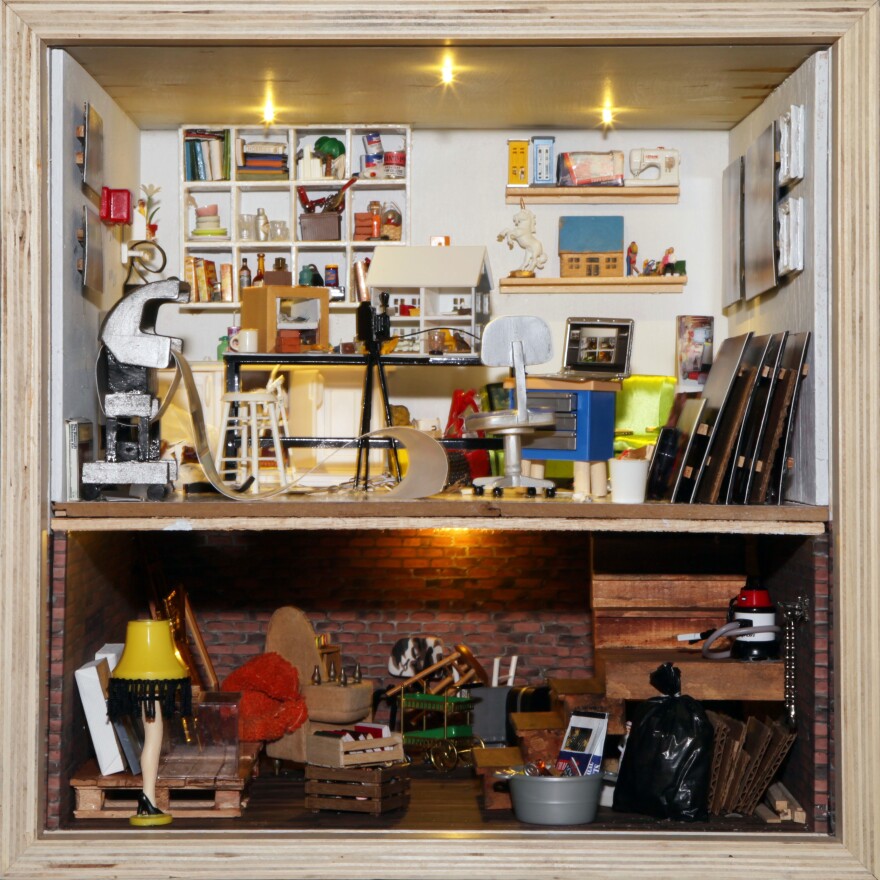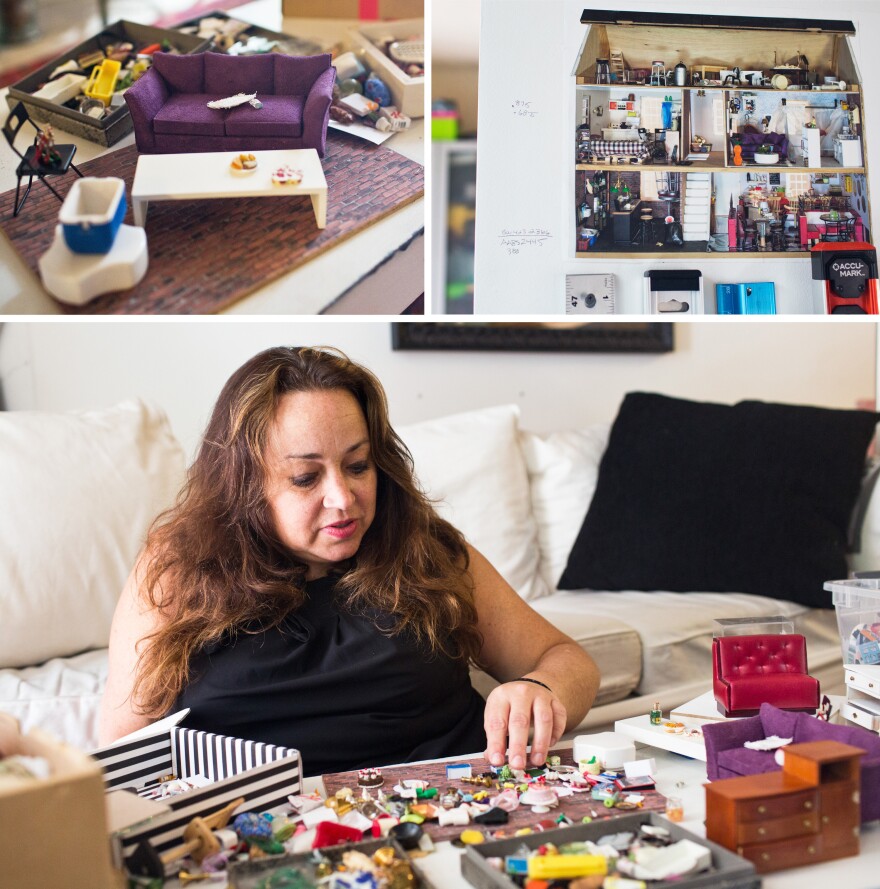When Bridget Sue Lambert was 5 years old, her grandfather built her a dollhouse.
It's a simple wooden structure, white with yellow shutters, a few handmade chairs and dressers scattered through its sparse rooms.
Decades later when Lambert was searching for artistic inspiration, she found out the dollhouse was still in her parents' house, gathering dust. Lambert's love of miniatures was sparked anew.
"What they say, psychologically, is you have control over a space," Lambert says, looking up at the dollhouse. It now sits on a shelf in the bedroom of her Washington, D.C., apartment, held together with a few pieces of blue tape at the corners.

Lambert, a 47-year-old real estate agent and art photographer, found her artistic outlet in creating and controlling these miniature scenes. Since 2007, plastic people and their tiny belongings have been her materials of choice.
"For me, it's a way for me to express what's going on in my life," Lambert says. "I think I can exert a little bit of control — but I don't really know if I do or not."
The dioramas are assembled piece by piece from eBay and specialty websites, then photographed: a few bucks for a bright yellow lamp, $30 for a leather couch, almost $80 for a vintage-looking diner chair. Her photos are oddly intimate, providing glimpses of miniature lives: embraces seen through a window, bedrooms in disarray, bottles of wine on living room tables.
One of her dioramas is part of a "Dream House" on display at the National Building Museum in Washington, D.C.
Assembled by the museum's curators, the project concludes the "Small Stories: At Home In A Dollhouse" exhibit (on display through January 2017); altogether, the collection considers how domestic and personal spaces have changed over the centuries, and the roles they play in American culture today.
It should be said that the dollhouses in the Building Museum are no Toys 'R' Us play sets. The 12 houses — on loan from London's Victoria & Albert Museum of Childhood — span 300 years of history, from a Georgian manor to a Modernist villa to a Pop Art, plastic high-rise.
But at the exhibit's end, curator Caitlin Bristol says, the museum wanted to bring the idea of the dollhouse into the present. She gave the same, empty, open-faced wooden box — measuring just 15 inches per side — to 24 artists, architects, and interior designers from around the United States, with no instructions but for them to create their own "dream room."

In comparison to the sturdy, sprawling dollhouses, Lambert's dream room feels tiny, even cramped. She calls the piece #unicornsarereal, and the diorama is a nearly faithful re-creation of the artist's studio she occupied for six years.
All 24 dioramas are presented side-by-side as a collective "house," but there's no cohesion to what's inside. And that's by design.
"It could be past or present or future, or anything from your own life or anything fantastical or imaginary," Bristol says.
One popular room, by Michigan artist L. Delaney, showcases an expansive library built into the walls of an ice cave. Another miniature was created by Resource Furniture. It's of an actual micro-apartment setup designed by the NYC firm nArchitects.

Among the spaces are a Gothic bath, meditation rooms, a fairy princess bedroom, and a few that are more nightmare than dream.
"There's escape, but there's also a little bit of fear mixed in here," says Brett Rodgers, the museum's vice president for marketing and communications, about the designs. "Maybe it's the modern sensibility to embrace that and show it more directly and explore that."
Historically, dollhouses were status symbols and family heirlooms, says Bristol, the curator. For daughters, they reinforced the values of upper-class domesticity.
"Until the late 19th century, it was really sort of to help little girls learn how to clean and decorate and everything like that," she says.
But the dollhouses also were aspirational objects.
"Even though we could be talking about upper middle class or wealthy people," Rodgers says, "there were many cases where it was a wish of what we were, not necessarily a reflection of our actual lives and houses."
In most cases, the dollhouses in the Building Museum are immaculately crafted and incredibly detailed. In comparison to the average house of today (and the average house of the dollhouses' own eras), they are a fantasy of some elegant and exclusive past.
"Architects are always trying to figure out their utopias," says Kendall Dorman, an architect from D.C., who also contributed to the "Dream House" exhibit. "We keep trying but we've never accomplished that. And we keep trying. We sometimes make the same mistakes we've always made."

In Dorman's dream room, several silver Airstream trailers, perched on poles, rise above the ground at varying heights. On one side, miniature babies and polar bears emerge from metallic tubes.
On the other, black block letters spell out a question: "r u 4ever happy yet?"
"Part of it is a little tongue in cheek, making fun of the whole small house movement," Dorman says. "But part of it is also, wouldn't it be cool?"
Dorman says he was surprised to be included in the project — he doesn't make dollhouses or work with miniatures, and his small firm rarely builds architectural models anymore.
But it started him thinking: How could you design a dream home not just for the rich, but for everyone?
Maybe the answer was something that already exists. The Airstream travel trailer, he says, was the original luxury tiny home. But it has potential to scale up.
"I think they were pretty interesting, because if everybody had one of those, I think you'd still be pretty happy," Dorman says. "You have everything you need right there: You got a bed, you got a table, you got a place to cook your food, you got air conditioning, and you got mobility."

As for Lambert, her studio had everything she needed as an artist. Like the original, the miniature version is packed to the brim with tiny books and craft supplies — some of which Lambert bought, others which she made herself. And as a tribute, many of her favorite objects now permanently reside in the dream room.
It's so faithful to her cluttered life, the draft table even has its own dream room box in progress.
"I went a little crazy, is what happened," Lambert says, laughing.
Her studio, which she occupied through a residency program at the Arlington Arts Center in Virginia, was something of a refuge. It was the one space in the world dedicated just to her artwork — a luxury that few artists, especially those living in a city, can afford.
After her residency ended this year, Lambert moved the studio into her apartment, converting half her bedroom into an area for miniature supplies and a photo printer. She now does most of her work sitting on the floor in front of the TV, figures and furniture spread out on the table in front of her.
"It's hard when you put that in your home, because your home is your home, so where is your creative space?" Lambert says. "It kind of is a special place that most artists protect."
Since finishing #unicornsarereal for the Building Museum, Lambert has yet to take on a new project. Occasionally, when she tries to find some miniature or prized piece of furniture, she'll remember that she left it in her dream room at the Building Museum— and won't be getting it back.
"Maybe it's a process of giving up," Lambert says, "of giving in to the dream."
She seems like she's only half-joking.
Copyright 2023 NPR. To see more, visit https://www.npr.org.




